 Official Methods of Analysis of AOAC INTERNATIONAL (22nd Edition)
Official Methods of Analysis of AOAC INTERNATIONAL (22nd Edition)
Contents
7.2.45
AOAC Official Method 939.01
Thallous Sulfate in Rodenticide Formulations
Get access
-
Published:January 2023
Cite
Thallous Sulfate in Rodenticide Formulations', in Dr. George W Latimer, Jr. (ed.), Official Methods of Analysis of AOAC INTERNATIONAL, 22nd Edition (
Extract
First Action 1939
Final Action
Weigh test portion containing 0.1–0.15 g Tl2SO4 (usually 10 g), transfer to 800 mL Kjeldahl flask, and add 25 mL H2SO4 followed by 5–10 mL HNO3. After first violent reaction ceases, heat until white fumes of H2SO4 appear. Add few drops fuming HNO3 and continue heating and adding HNO3 until organic matter is destroyed, as shown by colorless or light yellow solution. Cool, add 10–15 mL H2O, again cool, and wash contents of flask into 400 mL beaker, continuing washing until volume is 60–70 mL. Boil several minutes to remove all HNO3, cool, and filter into 400 mL beaker. Wash with hot H2O until volume in beaker is 175 mL, neutralize with NH4OH, and then slightly acidify with H2SO4 (1 + 4). Add 1 g NaHSO3 to ensure reduction of thallic to thallous state. Heat to bp, add 50 mL 10% KI solution (w/v), stir, and let stand overnight. Filter through tight Gooch containing two disks S&S 589 white ribbon paper covered by medium pad of glass wool. Wash four or five times with 10 mL portions 1% KI solution (w/v), and finally with absolute alcohol. Dry to constant weight at 105°C (1–1.5 h), and weigh as TlI.
Sign in
Personal account
- Sign in with email/username & password
- Get email alerts
- Save searches
- Purchase content
- Activate your purchase/trial code
- Add your ORCID iD
Purchase
Our books are available by subscription or purchase to libraries and institutions.
Purchasing information| Month: | Total Views: |
|---|---|
| April 2024 | 6 |
| July 2024 | 7 |
| September 2024 | 3 |
| November 2024 | 1 |
| December 2024 | 3 |
| January 2025 | 2 |
| February 2025 | 3 |
| March 2025 | 3 |




Get help with access
Institutional access
Access to content on Oxford Academic is often provided through institutional subscriptions and purchases. If you are a member of an institution with an active account, you may be able to access content in one of the following ways:
IP based access
Typically, access is provided across an institutional network to a range of IP addresses. This authentication occurs automatically, and it is not possible to sign out of an IP authenticated account.
Sign in through your institution
Choose this option to get remote access when outside your institution. Shibboleth/Open Athens technology is used to provide single sign-on between your institution’s website and Oxford Academic.
If your institution is not listed or you cannot sign in to your institution’s website, please contact your librarian or administrator.
Sign in with a library card
Enter your library card number to sign in. If you cannot sign in, please contact your librarian.
Society Members
Society member access to a journal is achieved in one of the following ways:
Sign in through society site
Many societies offer single sign-on between the society website and Oxford Academic. If you see ‘Sign in through society site’ in the sign in pane within a journal:
If you do not have a society account or have forgotten your username or password, please contact your society.
Sign in using a personal account
Some societies use Oxford Academic personal accounts to provide access to their members. See below.
Personal account
A personal account can be used to get email alerts, save searches, purchase content, and activate subscriptions.
Some societies use Oxford Academic personal accounts to provide access to their members.
Viewing your signed in accounts
Click the account icon in the top right to:
Signed in but can't access content
Oxford Academic is home to a wide variety of products. The institutional subscription may not cover the content that you are trying to access. If you believe you should have access to that content, please contact your librarian.
Institutional account management
For librarians and administrators, your personal account also provides access to institutional account management. Here you will find options to view and activate subscriptions, manage institutional settings and access options, access usage statistics, and more.